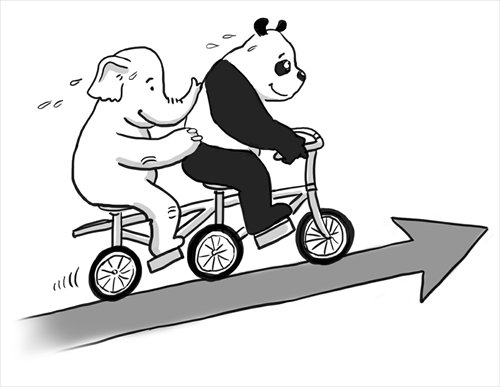


Illustration: Liu Rui/GT
According to the IMF, India is expected to grow at 6.5 percent in 2016, which will overtake China's projected growth rate of 6.3 percent. Analysis also shows that India might keep this leading position for quite a long time.
Some Western scholars are thrilled to hear this prediction, because they have finally found proof for their claim that India's "democratic system" gives more spur to development and innovation than China's "authoritarian system."
They always refer to the political systems of Western countries to analyze the economic growth in China and India, examining whether their political systems are similar or identical to those of the West.
Those who believe the political system is everything are actually not familiar with specific circumstances of China and India, especially the ethnic culture of the two. Thus, it is impossible for them to get a thorough understanding of the change of the two nations' growth rate.
If a country could upgrade its innovational ability only by having a similar system to the Western countries, there wouldn't be such an enormous gap between Germany and Greece, and countries in the eurozone wouldn't have the headaches that are troubling them these days.
The reason why China kept a faster growth rate than India over the past 30 years was that Chinese stuck to our fine traditions such as hard work.
India's then prime minister Jawaharlal Nehru once observed that a danger in India was that poverty might be deified. Contrary to that, the desire to be rich has been whetted among thousands of people in China since the country adopted the reform and opening-up policy.
Today's China and India are in different platforms of development with different national strength. The comparison of the growth rate between the two has lost its original meaning.
The Sino-US bilateral trade reached $521 billion in 2013, five-fold the figure of trade between India and the US, which was only $100 billion in the same year.
This indicates that the position and the share of China and India in the global industrial chain are totally different. India can stress that its system has provided good conditions for its innovation and development. But more significant factors to promote development lie in whether a country could improve its status and raise its share in the global industrial chain.
It is impossible to develop a large scale of sophisticated projects on a weak infrastructural foundation. The foundations of innovation require not only a system, but also industries, talent and the drive to pursue higher profit.
Neither China nor India should be involved in a battle of who is developing faster, or whose system is superior to the other. They should focus on in what fields they can enhance cooperation and complement each other economically.
China's development experience shows that once the growth rate of a big developing country with a large population, a wide range of industries and a solid foundation of development starts accelerating, it is bound to create more opportunities for its neighbors and the world to share its economic achievements.
The rule also applies to India. India's accelerating economic growth depends on its open trading system and vice versa. Only by sharing profits with neighboring countries, including China, can India sustain its economic growth rate. After all, under the background of globalization, no one can notch up rapid development with a closed door anymore.
China enjoys a dominant position in the manufacturing industry, especially given its advantages in low-end manufacturing. If India could leverage these, with its own labor cost advantages, it could create more jobs and raise the role of manufacturing in its own economy.
Most important of all, India will have a united, disciplined and skillful middle class by absorbing the huge numbers of rural laborers into its manufacturing industry.
The author is a senior editor with People's Daily. He is now stationed in Brazil. dinggang@globaltimes.com.cn. Follow him on Twitter at @dinggangchina
 PLA soldiers operating vehicle-mounted guns in drill
PLA soldiers operating vehicle-mounted guns in drill Beauties dancing on the rings
Beauties dancing on the rings Blind carpenter in E China's Jiangxi
Blind carpenter in E China's Jiangxi Top 10 highest-paid sports teams in the world
Top 10 highest-paid sports teams in the world In photos: China's WZ-10 armed helicopters
In photos: China's WZ-10 armed helicopters UFO spotted in several places in China
UFO spotted in several places in China Certificates of land title of Qing Dynasty and Republic of China
Certificates of land title of Qing Dynasty and Republic of China  Cute young Taoist priest in Beijing
Cute young Taoist priest in Beijing New film brings Doraemon's life story to China in 3D
New film brings Doraemon's life story to China in 3D China-S.Korea FTA sets positive precedent
China-S.Korea FTA sets positive precedent Ferry carrying 458 people sinks in Yangtze River
Ferry carrying 458 people sinks in Yangtze River Mecca of Marxism
Mecca of Marxism Bring them home
Bring them homeDay|Week